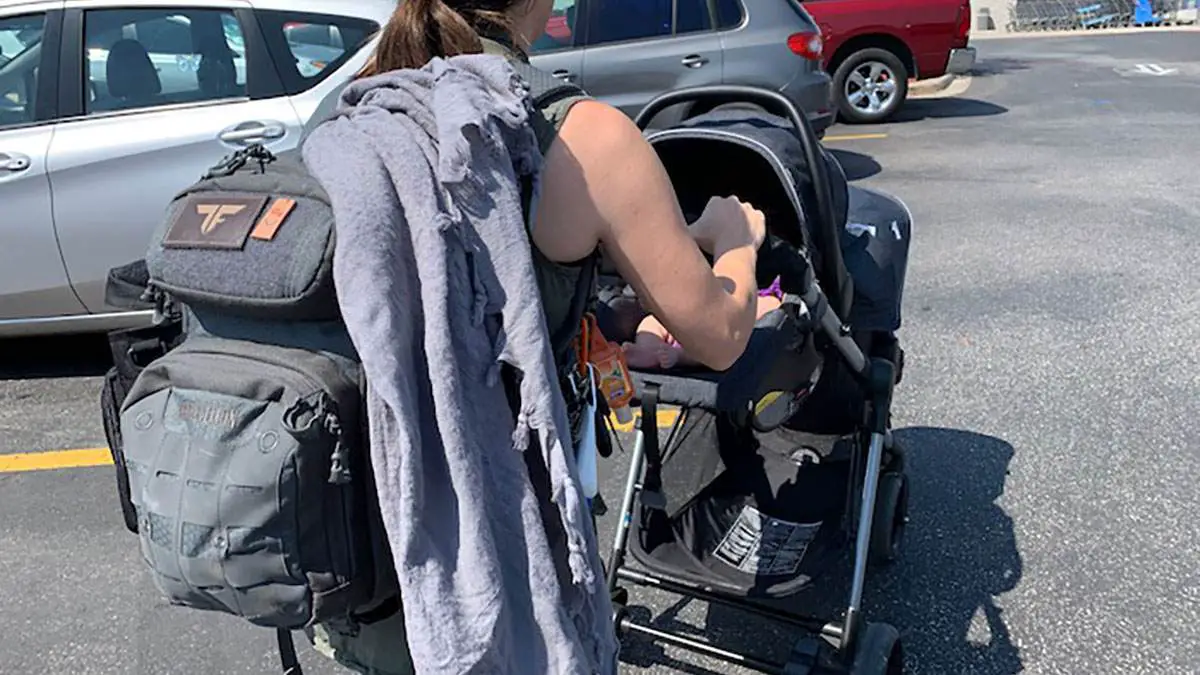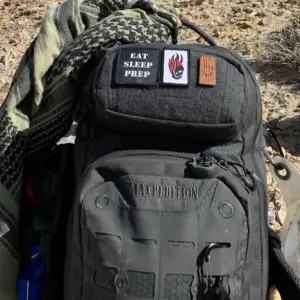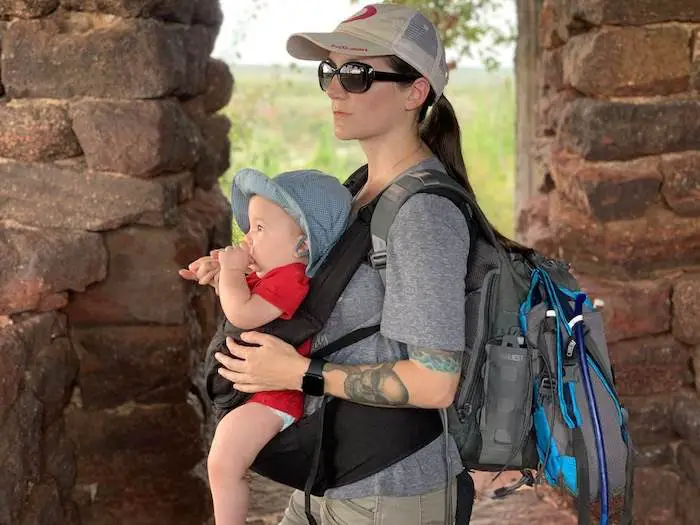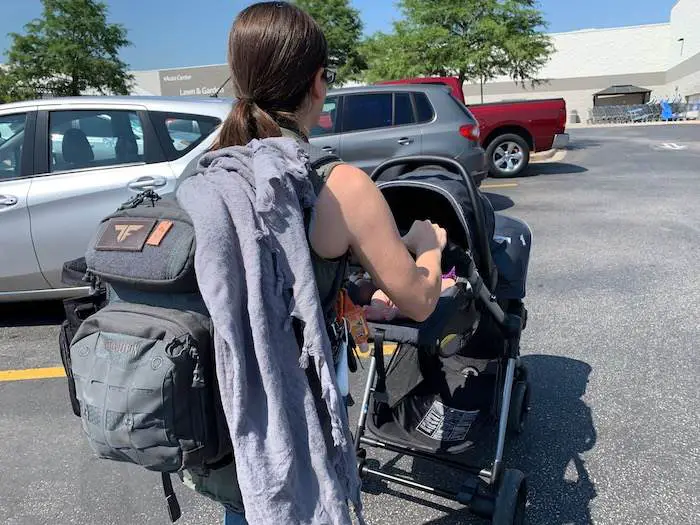Table of Contents
Building a get-home bag is one thing, but if you are wondering how to build a small get-home bag, that is something else.
It is easy just to pile more and more gear into a bag and call it good, covering all of your bases, but if you have to get home on foot, you must carry all of that gear. That can be tiring and slow you down!
Alternatively, if you are building a get-home bag to store in your car (you may also need to walk unexpectedly), storage space might be tight – particularly if you have a smaller vehicle.
A small get-home bag would also be helpful then. Let’s cover how to build one, what goes in a get-home bag, and a few other related things. But first…
What is a Get-Home Bag?
A “Get-Home Bag” is a bag or tote designed to carry gear necessary to get you back home in case of an emergency.
I have built many get-home bags over the years. It has evolved, and these days, it’s more of an EDC/get-home bag.
I’ll even hike with it. It’s a lot more than just a bag that sits in the vehicle. I use it pretty consistently for everyday items and it’s always being updated.
Mine is a bit smaller than most people’s, I think. I carry the necessary gear to get me from point A to point B with little to no stops. I also use it regularly, so I’m always replenishing the items inside of it frequently.
Important Things to Consider
We need to have some purpose behind the bags we make, whether a get-home bag or a bug-out bag. We can’t simply throw gear into it and hope it’ll work.
Let’s think of some questions we should ask ourselves before making the bag.
- How far do you work from home? How far do you usually travel for routine errands? Knowing how far you might have to walk in an emergency is an excellent baseline for determining your bag’s contents.
- Your physical abilities will determine the weight and supplies you will carry. The time it takes you to get to your destination may also depend on your physical ability.
Before I had kids, I walked home from work with a small get-home bag. It had very little in it except for some essential items.
I used a handful of things, but most of the time was simply focused on getting from point A to point B. I wasn’t stopping to sleep or make food; I was walking to get home.
It was a huge eye-opener to what was really ‘needed’. More than anything, I noticed my physical ability needed some adjustments.
Of course, I now have kids and I adjust the contents of my get-home bag based on my experience, but also what my kids need.
.embed-container { position: relative; padding-bottom: 56.25%; height: 0; overflow: hidden; max-width: 100%; } .embed-container iframe, .embed-container object, .embed-container embed { position: absolute; top: 0; left: 0; width: 100%; height: 100%; }
Why Build a Small Get-Home Bag?
One of the biggest lessons I learned from walking home is that I hardly touched my bag. I had some snacks, I drank some water, I took out my headlamp, and I used my phone charger. That was it.
Of course, we’re talking about peacetime, so I didn’t have anything to worry about.
I had all of my gear and was prepared to use it, but the gear that I used the most made me realize that if I had to get home as quickly as possible because of an emergency, I’m not messing around.
I’m going to be getting home as quickly as I possibly can, especially if I have my kids with me. I’m not going to compromise their safety. I’m just going to get home.
A small get-home bag will be:
- Easier to carry long distances
- Easier to keep in a vehicle without taking up too much
- Easier to handle with kids
- Easy for anyone to grab and go
Sometimes we can’t just think about ourselves in an emergency. What I mean by that is, what if you’re injured? Could someone else that usually travels with you carry and use that get-home bag?
It’s versatile, so everyone can take advantage of it at any time.
Plus, sometimes I need to carry my kids, so having a smaller bag is quite helpful.
Get Home Bag Gear
The gear inside of your bag should be deliberate and well organized. You need to be able to find these items quickly. They should be focused on getting you through 24 hours.
I put diapers and wipes into one Ziploc. I’ll then put extra clothes into another Ziploc. Food is in another Ziploc. I know that I can access my external battery and phone cord in the top pocket. I can access my first aid kit in the front zipper pocket, the same with my tourniquet.
Everything is organized.
If you don’t use the items in your bag regularly, be sure to inventory them at the change of each season. This is especially important with kids because their clothes will most likely need to be changed at least every year, if not more.
Food is another item that should be inventoried regularly.
Get Home Bag Food
What types of food should go into a get-home bag? We have some suggestions.
I think the get-home bag should be ready to eat. I shouldn’t need to stop and boil water for a freeze-dried entree.
Ready-to-eat foods are especially important for kids. I can hand my child a piece of jerky and she can keep walking.
Same with myself, I’m not interested in stopping for a quick meal. If I have to walk home because of an emergency, I’m not sure I’m going to want to be stopping anywhere for an extended period.
Ready-to-eat Items for Get-Home Bags
- Cereals (individually packed)
- Jerky
- Fruit, yogurt, and vegetable squeeze pouches
- Formula (if applicable)
- Tuna pouches (or the cracker/tuna packages)
- Goldfish and other individually wrapped crackers and snacks
- Granola/protein bars
- Survival tabs
- Gum and/or hard candies
- Small bags of chips
- Trail mix
- Ration bars
- Fruit snacks
Of course, food is subjective. I mentioned formula, but if you don’t have a baby on formula, that won’t apply to you.
Take a walk around the grocery store and find ready-to-eat foods that will work for you and your family.
Get Home Bag Checklist
These are general ideas, not an end-all-be-all. Use this checklist as a source to get ideas.
- Bag – backpack, roller bag, wagon, whatever.
- Footwear and extra socks
- Water
- Sillcock key
- Proper Seasonal Clothing
- Food
- Communications
- Defense item
- Pocket Knife
- Fire Starters
- Quality Flashlight or headlamp
- Medications
- Pocket Weather Radio
- Cash
- First Aid Kit
- Cookstove
- Mess Kit with Utensils
- Hand Warmers
- Paracord
- Gorilla tape
- Mylar Blankets
- Pen & Paper
- Toiletries
- Masks
- Bandana or a Quality Shemagh
- Map & Compass
- Diapers (if applicable)
- Wipes
- Sunscreen/bug spray
Additional Get Home Bag Items
If you drive everyday then you can stash your car with a few additional items besides the get home bag.
- Hatchet
- Chainsaw or axe
- Pry (to open gates and doors)
- Advanced first aid
- Water bottle (stainless steel)
- Use-and-throw cups
- Ziploc bags
- Chalk (to write something)
- Blanket
- Small coffee sachets (act as a great comfort drink)
- USB cable
- Pen, pencil and notepad
- Foot powder
- Butane lighter
- Hand sanitizer
- Large trash bags
- Lip balm (used a fire starter)
- A sewing kit (repair torn fabrics)
- Umbrella
Let’s Test
Now that you have prepared your GHB well and included all the necessary items, let’s take a test. It is equally important for you to be familiar with the situation in advance to avoid the problems you may face at one go.
Drills are very important as they uncover several holes that you may oversee otherwise. Also, you can test whether you are capable of making into home within time. Further, you can level up every time to go through harsh conditions each time to get better at this.
You’ll have to create tough scenario to make use of the items in your GHB and get out of the situation within framed time.
Small Get Home Bag Summary
Take the time to practice carrying your bag over a distance. I take my bag out when we go hiking, it not only helps me examine my needs for me and my kids, but it also helps me generally train with it.
Remember, a “Get Home Bag” is different than your Bug out Bag (BOB). Your BOB will contain more items for survival and is designed to get you to your destination over several days or more.






![[Tutorial] How to Build a Bug Out Bag Correctly [Tutorial] How to Build a Bug Out Bag Correctly](https://homesteadandprepper.com/wp-content/uploads/2015/02/disaster.jpg)





